8 Best Native Plants for Tulsa, OK
BY CALEB LEONARD | APRIL 6TH, 2023 | LANDSCAPING, OKLAHOMA, TULSANestled between the Ozarks and the Great Plains, Tulsa has a lush, hilly landscape that produces beautiful native flora. This article highlights the best native plants for Tulsa, OK. Here we will discuss the benefits of integrating native plants into your landscape, highlight a few native species, and answer some frequently asked questions about native planting.
Native plants have had thousands of years to develop in a particular ecosystem. With that much local experience, the native plants covered in this article need virtually no assistance to thrive in Tulsa’s temperate climate.
Other perks of growing native plants include:
- Native plants offer food and shelter for local wildlife.
- They require less fertilizer and water than other plants.
- Native plants are heartier and less susceptible to pests and diseases.
- These plants are accustomed to the temperature swings of northeastern Oklahoma.
In this article, we’ll cover the following:
- Bluestar
- Coneflowers
- Indian Blanket
- Eastern Redbud
- Purple Passion Vine
- Butterfly Milkweed
- Bitternut Hickory
- Wild Hyacinth
- How to Choose Native Plants for Your Tulsa Landscape
- FAQ About Native Tulsa Plants
- Where to Find Native Plants in Tulsa
Native Plants for Your Tulsa Yard
1. Bluestar (Amsonia tabernaemontana)
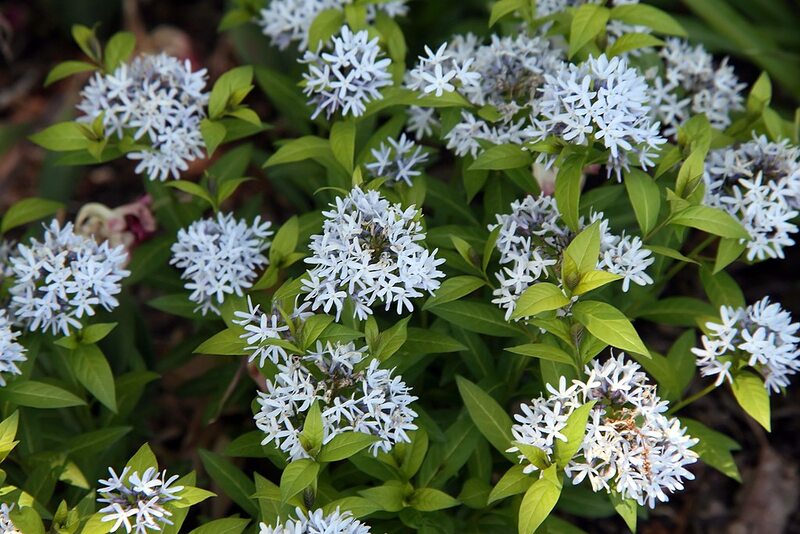
Photo Credit: David J. Stang / Wikimedia Commons / CC BY-SA 4.0
Bluestar is a medium-sized shrub that compliments the landscape of Oklahoma with its four-season interest. This shrub produces clusters of small powder-blue flowers from March until May. The star-shaped blooms attract pollinators like hummingbirds, butterflies, and carpenter bees. This herbaceous perennial has soft green stems and leaves that turn a buttery yellow in the fall.
Bluestar prefers full sun but tolerates partial shade. It has a vase-shaped growth pattern, with wax stems that are toxic to ingest, so any whitetail deer that pop in won’t hang around. This shrub is not prone to disease and is available in dwarf varieties, such as ‘Blue ice,’ if you need to landscape a small space.
Plant type: Perennial shrub
USDA Hardiness Zone: 3 to 9
Sun: Full sun/partial shade
Soil: Loamy, moist soil
Bloom time: March-May
Fragrance: Sweet, delicate scent
Water needs: Needs frequent watering (should never dry out)
Mature height: 24 to 36 inches
Potential hazards: Toxic (dogs, cats, humans)
Maintenance: Low. Cut one-third of the plant back each spring.
2. Coneflower (Echinacea)
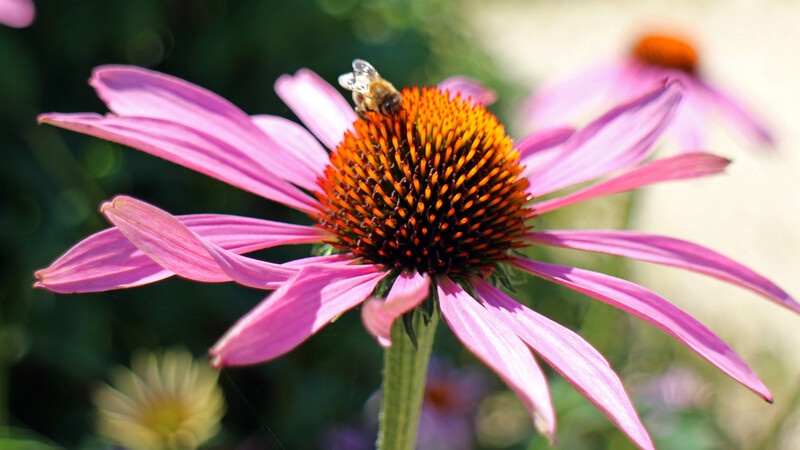
Photo Credit: Wallpaper Flare
Echinacea has been used for medicinal purposes for centuries, but Tulsa residents probably recognize this distinct perennial as a local wildflower. Named after the Greek word ‘echinus,’ which means hedgehog, this flower has a spikey, cone-shaped center that attracts bees, butterflies, and other pollinators.
These native flowers grow 2 to 4 feet tall and produce blooms from July through September. As the plant matures, its petals droop, highlighting the coneflower’s signature cone shape. A sun-loving flower, this plant is accustomed to the fertile loam of the prairies; however, it will tolerate dryer, sandy soils.
The coneflower is available in yellow, red, orange, purple, and white, with purple being the most common. Plant a variety of colors for a cheerful springtime look, and be sure they get plenty of sunlight.
Some coneflower varieties worth exploring:
- Purple coneflower (Echinacea purpurea)
- Yellow coneflower (Echinacea paradoxa)
- Red sombrero coneflower ( Echinacea Balsomed)
- Pink coneflower (Echinacea purpurea ‘Pica Bella’)
- White coneflower (Echinacea purpurea ‘PowWow White)
Most coneflowers rebloom without deadheading, which adds to their low-maintenance appeal.
Plant type: Flowering perennial
USDA Hardiness Zone: 4 to 9
Sun: Full sun
Soil: Prefers fertile loam, tolerates clay
Bloom time: June to August
Fragrance: Light and sweet
Water needs: 1 inch of water weekly.
Mature height: 2 to 4 feet
Maintenance: Low. Water weekly, add a layer of compost in the spring. Cut back in the fall.
3. Indian Blanket (Gaillardia pulchella)
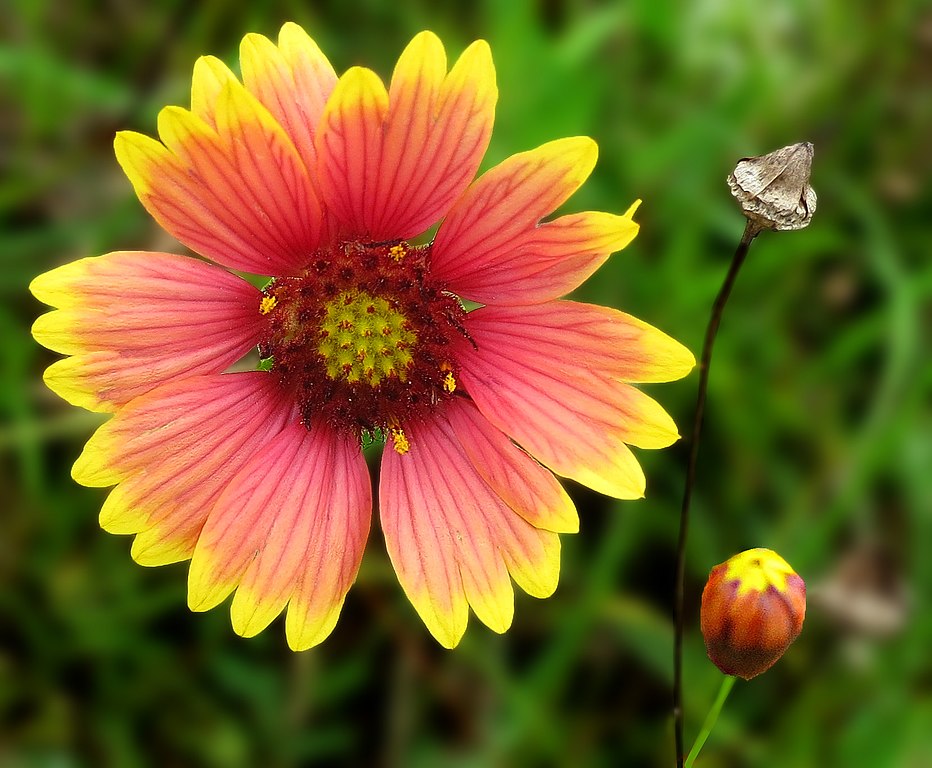
Photo Credit: Jim Evans / Wikimedia Commons / CC BY-SA 4.0
Indian blanket is Oklahoma’s state wildflower. This colorful flower gets its name from how its blooms blanket the ground with vibrant color patterns often found in Native American weaving baskets. A member of the daisy family, this multi-tonal flowering plant has a reddish-pink center that bleeds to yellow towards the tips of the petals.
Easy to care for and drought-tolerant, Indian blanket blooms from May through July, and occasionally the colorful blooms continue into the fall. Pollinators are drawn to these flowers’ colors and sweet fragrances, making them an excellent addition to butterfly gardens.
Plant type: Flowering annual
USDA Hardiness Zone: 3 to 9
Sun: Full sun
Soil: Poor soils, slightly acidic, well-drained soil.
Fragrance: Depending on the habitat, the scents range from licorice to bubblegum.
Bloom time: May to August
Water needs: Water daily during germination. Then after blooms appear, you may water once or twice a week when the ground dries out.
Mature height: 1.5 to 2 feet
Potential hazards: aphids and thrips, Aster yellow
Maintenance: No maintenance is required.
4. Eastern Redbud (Cercis canadensis)
This list of native plants would be incomplete without mentioning Oklahoma’s state tree, the eastern redbud. Favored for its stout stature and brilliant violet blooms in spring, the Oklahoma redbud has heart-shaped leaves that turn golden yellow in the fall. This tree adds four-season interest to Tulsa’s hilly forests. This redbud is also remarkably drought-tolerant.
This deer-resistant tree is excellent for smaller yards in need of visual interest. As one of the first trees to bloom each year, the redbud’s bloom proclaims spring’s arrival. Due to its deep root systems, the eastern redbud can withstand Tulsa’s harsh winters.
Plant type: Flowering deciduous tree
USDA Hardiness Zone: 6 to 9
Sun: Full sun, part shade
Soil: Clay, loam, sand
Fragrance: Sweet pea
Seasons of interest: Purple blooms in spring, and leaves turn yellow in the fall.
Water needs: Minimal.
Mature height: 20 to 25 feet
Maintenance: Fertilize annually and add mulch. Prune after blooming as needed.
5. Purple Passion Vine (Passiflora incarnata)
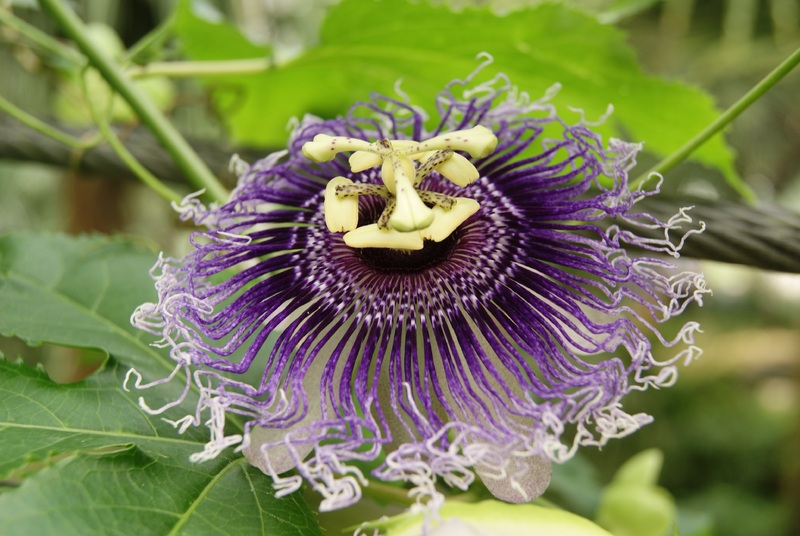
Photo Credit: PxHere
Passion flowers may be synonymous with the tropics, but the purple passion vine stems from Texas and Oklahoma. This tenacious vine can grow up to 25 feet long and produces unique purple flowers that add a regal touch to arches and trellises. In addition to producing flowers, this vine produces edible fruit, which is used to relieve anxiety and sleep problems.
This low-maintenance vine is considered drought-tolerant; however, it needs regular moisture to produce flowers and fruit from mid-summer through fall. The uniquely shaped flowers have spaced-out petals surrounded by a dazzling array of thin, crimped, hair-like segments that lend an exotic feel to any Oklahoma garden. The vine blooms spring through the fall, though most blooms last only 24 hours.
Plant type: Herbaceous flowering vine
USDA Hardiness Zone: 7 to 11
Sun: Full sun/ partial shade
Soil: Rich, non-saline clays, loams, and san
Fragrance: Sweet, tropical. Reminiscent of grapes.
Bloom time: May to August
Water needs: 1 inch to 1.5 inches of water every week.
Mature height: 8 feet tall, 25 feet long
Maintenance: Fertilize in spring, prune in early spring.
6. Butterfly Milkweed (Asclepias tuberosa)
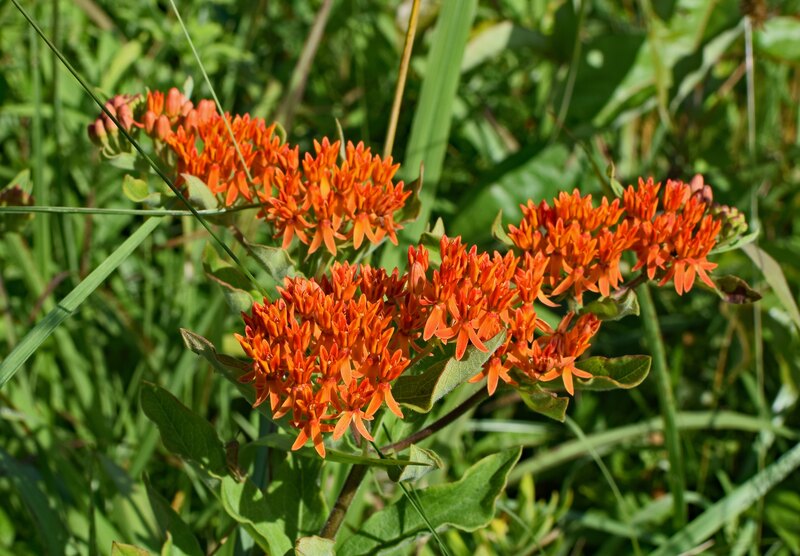
Photo Credit: PxFuel
If you want to lure butterflies to your garden, try planting butterfly milkweed. Monarch butterflies only lay their eggs on this wildflower, which the caterpillars use as a food source while growing. Twenty-five milkweed cultivars are native to Oklahoma, so gardeners should have no problem selecting the perfect native specimen for their lawns.
Don’t be deterred by the term “weed’–– this plant produces clusters of small, orange, star-shaped flowers that bring a burst of unexpected color to any landscape. This herbaceous perennial loves sunlight and is drought-tolerant. Thanks to its long tap root, this plant only needs an inch of water a week.
This plant releases seed pods in the fall and can become invasive. To stop the unwanted spread around your home garden, you’ll need to cut off the seed pods in late summer.
Plant type: Herbaceous perennial
USDA Hardiness Zone: 3 to 9
Sun: Full sun
Soil: Dry soil, well-drained
Fragrance: Sweet vanilla
Bloom time: June to August
Water needs: 1 inch per week
Mature height: 2 feet
Potential hazards: Toxic if ingested by people, pets, and livestock.
Maintenance: Avoid overwatering established plants. Do not fertilize.
7. Bitternut Hickory (Carya cordiformis)
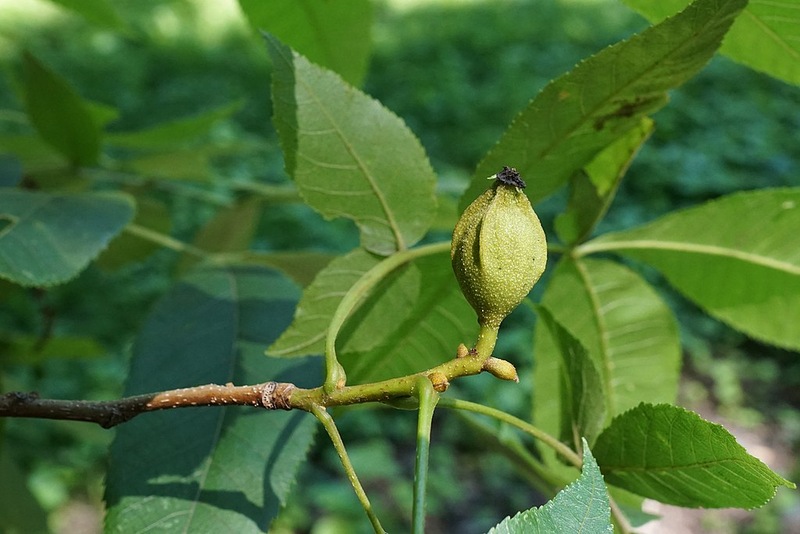
Photo Credit: Plant Image Library / Wikimedia Commons / CC BY-SA 2.0
A deciduous tree that bridges the divide between the hilly forests and prairie land around Tulsa, the bitternut hickory is among the tallest trees in the hickory family. This tree reaches heights of 60 to 80 feet and provides excellent shade. Its long, narrow leaves with serrated edges fade from green to bright yellow each fall. This hickory holds its spectacular foliage longer than most trees.
The bitternut tree is named after the bitter-tasting nuts it produces when it blooms each April. Male flower clusters bond together to make green, rope-like tendrils called catkins, while female flowers produce the bitter fruit after which the tree is named.
The nuts of the bitternut hickory might be too bitter for the human palate, but they are a favorite among squirrels, raccoons, foxes, chipmunks, and rabbits.
Plant type: Deciduous perennial tree
USDA Hardiness Zone: 4 to 9
Sun: Full sun/ partial shade
Soil: Loam and well-drained quartz sands
Bloom time: April
Water needs: an inch per week
Mature height: 60 to 80 feet
Maintenance: Avoid overwatering established plants.
8. Wild Hyacinth (Camassia scilloides)
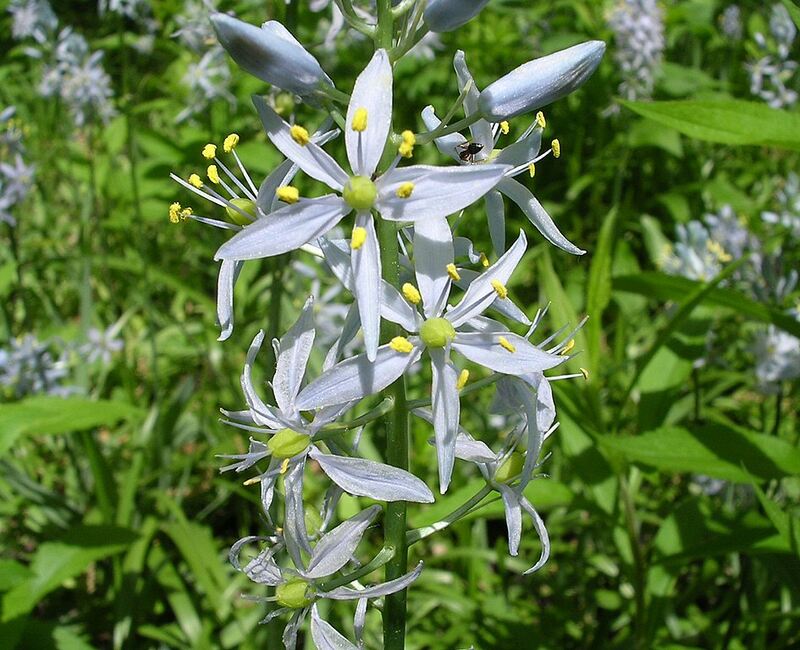
Photo Credit: Jay Sturner / Wikimedia Commons / CC BY 2.0
A clump-forming bulbous perennial, the wild hyacinth produces upright clusters of small flowers called racemes. These star-shaped flowers are mostly white but can also be found in lavender, pink, and blue.
They reseed themselves; however, they are easier to grow from bulbs. Plant the bulbs 4 to 6 inches apart for best results. Like lilies, irises, and other blossoming springtime bulbs, the wild hyacinth has a relatively short bloom time.
After your hyacinths have finished flowering, remove their blooms, but do not remove their foliage. In order to produce next year’s blooms, bulbs need their leaves to gather energy. Foliage will naturally die back at the end of spring. To prevent fungal diseases, remove the leaves once they have turned brown.
Plant type: Perennial wildflower
USDA Hardiness Zone: 4 to 8
Sun: Full sun/ partial shade
Soil: Rich, acidic soils, chalk, loam, sandy soil.
Bloom time: May to June
Scent: Heavy, earthy, and sweet.
Water needs: Regular moisture during the growing season. Water when the soil is dry at a depth of 3 inches.
Mature height: 2 feet
Maintenance: Avoid overwatering established plants.
How to Choose Native Plants for Your Tulsa Yard
Tulsa, Oklahoma, sits within zone 7 on the USDA hardiness zone map, meaning wintertime temps can drop to negative 18 degrees Fahrenheit. Native plants are accustomed to eastern Oklahoma’s winters and will return to life each spring.
All plants have unique sun, soil, and water requirements, so consider these needs when planting. Also, consider your plant’s mature size when spacing your specimens to avoid overcrowding.
Ask your local plant nursery about resources for native seeds and plants. You can even find landscapers who specialize in native plant gardening if you want a professional to set up your eco-friendly yard.
FAQ About Native Tulsa Plants
While digging up a plant from a nearby meadow or prairie may be tempting, transplanting a wild specimen is not a good idea. Digging up native plants disrupts local ecosystems. Plus, some native species are endangered, and transplanting them risks killing them.
Autumn and early spring are the best times to plant native plants because the cooler temperatures and increased precipitation make for a gentler introduction to the new environment.
The beauty of native plants is their low-maintenance needs. Even before planting, most native species need no special treatment. You may aerate the soil and add 0.5 to 1 inch of compost to the soil, but no preparation is necessary.
Where to Find Native Plants
It can be difficult to find native plants at national garden warehouse retailers. Check out these local nurseries for native Tulsa species.
- Southwood Landscape and Garden Center
- Rancho Flores of Tulsa
- Colebrook Nursery of Tulsa
- Under the Sun Garden Center
Even though Oklahoma’s native plants don’t need much attention, your landscape may begin to look a little too wild without partial interference. Thankfully, a local lawn care pro can tame your yard’s turf, hedges, and edging to achieve the manicured look.